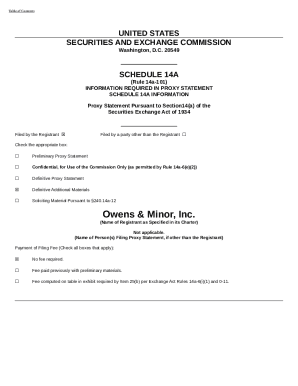Understanding Proxy Statements (Form DEF 14A): A Comprehensive Guide

Table of Contents
What are Proxy Statements (Form DEF 14A)?
Proxy statements are formal documents that publicly traded companies file with the Securities and Exchange Commission (SEC) to solicit shareholder votes on important matters. Their purpose is to provide shareholders with the information necessary to cast informed votes on proposals put forth by the company's management or other shareholders. This transparency is a cornerstone of effective corporate governance.
- Who Files Them? Companies required to register with the SEC under the Securities Exchange Act of 1934, generally those with publicly traded securities, must file Form DEF 14A.
- When are they Filed? Proxy statements are typically filed several weeks before a company's annual or special shareholder meeting. The exact timing varies depending on the company and the nature of the matters being voted on.
- Key Information Included: Proxy statements are comprehensive documents containing a wealth of information, including:
- Executive compensation and benefits
- Details about the board of directors and their nominees
- Shareholder proposals
- Information about mergers, acquisitions, or other significant corporate transactions
- Auditor reports
- Other significant corporate matters requiring shareholder approval
Key Sections of a Proxy Statement to Analyze
Effectively using a proxy statement requires focusing on key sections. Let's delve into some of the most crucial areas for analysis:
Executive Compensation
Scrutinizing executive compensation is crucial for evaluating shareholder value and potential agency problems. Reviewing executive pay helps assess whether management is appropriately incentivized to act in the best interests of the company.
- Specific elements to look for:
- Base salary, bonuses, and stock options
- Pay ratios comparing CEO compensation to the median employee compensation
- "Golden parachutes" – severance packages for executives in the event of a change in control
- Keywords: Executive pay, compensation disclosure, shareholder value, CEO pay, executive compensation packages.
Board of Directors
The composition and independence of the board of directors are critical aspects of corporate governance. A diverse and independent board is better positioned to provide effective oversight.
- Information to seek:
- Director backgrounds, experience, and expertise
- Committee memberships (audit, compensation, nominating)
- Director independence – assessing whether directors have any material relationships with the company that could compromise their objectivity.
- Keywords: Board composition, corporate governance, director nominations, board independence, audit committee.
Shareholder Proposals
Shareholder proposals allow individual investors to voice their concerns and influence company policy. These proposals often cover a range of topics reflecting growing shareholder activism.
- Types of proposals:
- Environmental, Social, and Governance (ESG) initiatives
- Executive compensation reforms
- Social responsibility initiatives
- Political contributions
- Keywords: Shareholder activism, corporate social responsibility, ESG investing, shareholder engagement.
Mergers and Acquisitions
Proxy statements provide detailed information about significant corporate transactions, such as mergers and acquisitions. This information is crucial for understanding the strategic direction and potential risks associated with such deals.
- Key data points to look for:
- Transaction terms and conditions
- Valuation of the target company
- Rationale behind the transaction
- Potential risks and benefits
- Keywords: M&A activity, corporate transactions, due diligence, mergers and acquisitions, acquisition targets.
How to Access and Understand Proxy Statements
Accessing and interpreting proxy statements is straightforward, with a wealth of resources available.
- Where to Find Them: The SEC's EDGAR (Electronic Data Gathering, Analysis, and Retrieval) database is the primary source for locating proxy statements (Form DEF 14A). You can also typically find them on the company's investor relations website.
- Tips for Reading and Interpreting: Start with the summary, then focus on the sections most relevant to your interests. Don't hesitate to look up unfamiliar terms or concepts. Consider seeking professional advice if needed for complex financial information.
- Using Proxy Statement Analysis Tools: Several third-party services provide tools to analyze and compare proxy statement data, streamlining the process.
Conclusion
Understanding Proxy Statements (Form DEF 14A) is essential for informed investing and active participation in corporate governance. By carefully reviewing these documents, you gain valuable insights into a company's leadership, compensation practices, strategic direction, and overall health. Mastering the art of understanding Proxy Statements (Form DEF 14A) empowers you to become a more informed and active investor. Bookmark the SEC's EDGAR database (www.sec.gov/edgar/searchedgar/companysearch.html) to easily access these vital documents and participate in shaping the future of the companies you invest in.

Featured Posts
-
 Ujedinjeni Arapski Emirati Destinacija Za Avanturu I Luksuz
May 17, 2025
Ujedinjeni Arapski Emirati Destinacija Za Avanturu I Luksuz
May 17, 2025 -
 Valerio Therapeutics S A Postponement Of 2024 Financial Report And Statement Approval
May 17, 2025
Valerio Therapeutics S A Postponement Of 2024 Financial Report And Statement Approval
May 17, 2025 -
 Footballs Evolution Josh Cavallo And The Fight For Lgbtq Inclusion
May 17, 2025
Footballs Evolution Josh Cavallo And The Fight For Lgbtq Inclusion
May 17, 2025 -
 Mariners Vs Athletics Whos On The Injured List March 27 30
May 17, 2025
Mariners Vs Athletics Whos On The Injured List March 27 30
May 17, 2025 -
 These Fortnite Skins Are Probably Gone Forever
May 17, 2025
These Fortnite Skins Are Probably Gone Forever
May 17, 2025
Latest Posts
-
 Donald Trumps Family Tree Exploring The Generations Of The Trump Family
May 17, 2025
Donald Trumps Family Tree Exploring The Generations Of The Trump Family
May 17, 2025 -
 Boston Celtics Sold For 6 1 B Fans React To Private Equity Ownership
May 17, 2025
Boston Celtics Sold For 6 1 B Fans React To Private Equity Ownership
May 17, 2025 -
 Understanding The Trump Family A Detailed Look At The Presidents Lineage
May 17, 2025
Understanding The Trump Family A Detailed Look At The Presidents Lineage
May 17, 2025 -
 Celtics Vs Pistons Game Prediction Will The Celtics Stay Hot
May 17, 2025
Celtics Vs Pistons Game Prediction Will The Celtics Stay Hot
May 17, 2025 -
 Nba Playoffs Prediction 76ers Vs Celtics Who Will Advance
May 17, 2025
Nba Playoffs Prediction 76ers Vs Celtics Who Will Advance
May 17, 2025
